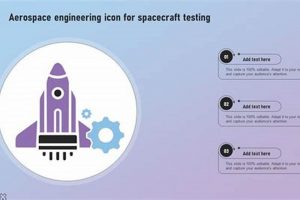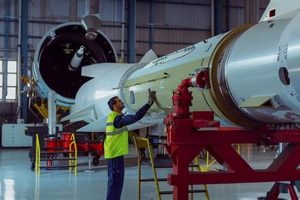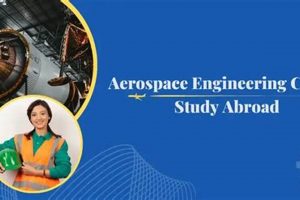Aerospace engineers are involved in the design, development, testing, and production of aircraft, spacecraft, and missiles. Their work encompasses a wide range of activities, from conceptualizing new vehicle designs to analyzing flight performance and ensuring structural integrity. The specific tasks undertaken vary depending on the specialization and employer.
The field’s significance stems from its contribution to scientific discovery, national defense, and commercial air travel. Advancements in aerospace engineering have enabled space exploration, improved air transportation safety and efficiency, and facilitated the development of innovative technologies with applications beyond the aerospace sector. Historically, innovations in this engineering field have been driven by both military and civilian needs, leading to continuous advancements in materials, propulsion systems, and aerodynamic design.
This examination explores the multifaceted roles these professionals play in the construction of launch vehicles, detailing the specialized knowledge and skills required for each stage of the process, and clarifying the extent of their involvement. It will further differentiate between the various specializations within this engineering field and the specific responsibilities they hold within the larger project context of creating machines that can travel beyond Earth.
Guidance Regarding the Construction of Rockets by Aerospace Engineers
This section provides key considerations for aspiring or practicing aerospace engineers engaged in rocket development. These guidelines emphasize crucial aspects of the design, development, and testing phases.
Tip 1: Prioritize System-Level Thinking: Comprehensive understanding of the entire launch vehicle system is crucial. Engineers must consider interactions between subsystems, including propulsion, avionics, and structural components, to optimize overall performance.
Tip 2: Master Fundamental Principles: Solid understanding of aerodynamics, thermodynamics, propulsion, and structural mechanics forms the bedrock of successful rocket design. Focus on rigorous application of these principles.
Tip 3: Emphasize Rigorous Testing and Validation: Comprehensive testing at the component, subsystem, and system levels is imperative. Employ a combination of analytical modeling and empirical data to validate design performance and identify potential vulnerabilities.
Tip 4: Embrace Interdisciplinary Collaboration: Rocket development necessitates close collaboration with engineers from diverse disciplines, including electrical, mechanical, and software engineering. Effective communication and teamwork are essential.
Tip 5: Adhere to Stringent Safety Standards: Rocket operations inherently involve significant risk. Engineers must rigorously adhere to established safety protocols and implement robust safety measures throughout the design, manufacturing, and testing processes.
Tip 6: Continuously Learn and Adapt: The aerospace field is constantly evolving. Maintaining awareness of emerging technologies, materials, and design techniques is crucial for remaining competitive and contributing to innovation.
Tip 7: Optimize for Reliability and Maintainability: Design rockets for long-term reliability and ease of maintenance. Consider factors such as component accessibility, environmental protection, and failure mode effects analysis (FMEA) during the design phase.
Adherence to these guidelines facilitates the successful development and deployment of robust, reliable, and efficient launch vehicles. By emphasizing fundamental principles, rigorous testing, and interdisciplinary collaboration, engineers enhance the likelihood of mission success and contribute to the advancement of space exploration.
This guidance serves as a valuable resource for those involved in rocket construction, providing a framework for navigating the complex challenges inherent in this demanding engineering discipline.
1. Design and Analysis
Design and Analysis forms the foundation of rocket development. These processes determine the vehicle’s functionality, performance characteristics, and overall viability. The expertise brought to bear in this phase dictates the success of subsequent manufacturing and operational stages.
- Aerodynamic Modeling
Aerodynamic modeling involves creating computational simulations and wind tunnel tests to understand how air flows around the rocket during flight. This information guides the design of the vehicle’s shape to minimize drag, maximize lift (where applicable), and ensure stability. Incorrect aerodynamic modeling can lead to unpredictable flight paths or structural failure.
- Structural Analysis
Structural analysis assesses the integrity of the rocket’s components under various stress conditions. Finite element analysis (FEA) is commonly used to simulate the effects of launch forces, aerodynamic loads, and thermal stresses on the rocket’s frame and skin. This analysis helps identify weak points and ensures the vehicle can withstand the rigors of flight. For instance, it is used to calculate the necessary thickness of the rocket’s walls or the optimal placement of reinforcing structures.
- Trajectory Optimization
Trajectory optimization calculates the most efficient flight path for a rocket to reach its intended destination. This involves considering factors such as gravity, atmospheric drag, and engine performance. Sophisticated algorithms are used to determine the optimal launch angle, engine burn times, and guidance maneuvers. Efficient trajectory optimization reduces fuel consumption and maximizes payload capacity.
- System-Level Simulation
System-level simulation integrates all aspects of the rocket’s design into a single model. This allows engineers to simulate the entire launch sequence, from liftoff to payload deployment. Such simulations can uncover unexpected interactions between subsystems and identify potential problems before physical prototypes are built. For example, it can reveal how vibrations from the engine might affect the avionics system.
The successful implementation of these design and analysis activities is crucial for aerospace engineers involved in rocket construction. These processes reduce risk, optimize performance, and ensure the reliable operation of launch vehicles. Through rigorous modeling and simulation, engineers can identify and mitigate potential issues before they manifest in costly failures.
2. Propulsion Systems
Propulsion systems are integral to the development and operation of rockets. These systems generate the thrust necessary to overcome gravity and propel the vehicle into space, directly impacting payload capacity, mission duration, and overall success. Consequently, aerospace engineers specializing in propulsion play a critical role in this endeavor.
- Rocket Engine Design
Rocket engine design involves configuring the combustion chamber, nozzle, and propellant feed system to optimize thrust and efficiency. Aerospace engineers select appropriate propellants (liquid or solid) based on mission requirements and design the engine to maximize the conversion of chemical energy into kinetic energy. For instance, the design of the Space Shuttle’s main engines involved complex thermodynamic analysis and material selection to withstand extreme temperatures and pressures.
- Propellant Management
Efficient propellant management is crucial for maximizing rocket performance. Engineers design propellant tanks, pumps, and control systems to ensure a consistent and controlled flow of fuel and oxidizer to the engine. Sloshing effects, propellant settling, and boil-off rates are carefully considered to prevent disruptions in engine operation. The cryogenic propellant systems used in the Saturn V rocket, for example, required sophisticated insulation and venting techniques to minimize propellant losses.
- Thrust Vector Control
Thrust vector control (TVC) allows engineers to steer the rocket in flight by manipulating the direction of the engine’s thrust. Gimbaled engines, vernier thrusters, and jet vanes are common TVC mechanisms. Effective TVC is essential for maintaining stability, correcting course deviations, and achieving precise orbital insertion. SpaceX’s Falcon 9 rocket uses gimbaled engines and cold gas thrusters for precise control during landing maneuvers.
- Engine Testing and Qualification
Rigorous testing and qualification are essential to ensure the reliability of rocket engines. Engineers conduct static fire tests to measure thrust, chamber pressure, and other performance parameters. Environmental testing simulates the conditions of space, including vacuum, temperature extremes, and vibration. These tests identify potential weaknesses and ensure that the engine meets performance specifications. The development of the RS-25 engines for the Space Launch System (SLS) involved extensive testing to validate their performance and durability.
These facets of propulsion system engineering demonstrate the critical role played by these engineers in rocket construction. From initial design to final testing, their expertise ensures that rockets can reliably and efficiently accomplish their intended missions. Further research and development in propulsion technology continue to drive advancements in space exploration and access.
3. Structural Integrity
Structural integrity constitutes a foundational element in the successful fabrication and operation of rockets. These vehicles must withstand immense stresses during launch, flight, and re-entry, making structural robustness paramount. Aerospace engineers dedicated to rocket construction bear direct responsibility for ensuring that a rocket’s design, materials, and assembly meet stringent requirements for withstanding these forces. The consequences of structural failure range from mission abort to catastrophic destruction, thereby emphasizing the critical role of structural integrity in the broader context. For example, the investigation following the Challenger disaster revealed deficiencies in the structural design and materials used in the solid rocket boosters, highlighting the fatal consequences of inadequate structural analysis and quality control.
Aerospace engineers employ a variety of advanced techniques to assess and enhance structural integrity. Finite element analysis (FEA) is used to simulate the effects of various loads on the rocket’s structure, identifying potential stress concentrations and areas of weakness. Material selection is also crucial, with engineers choosing lightweight, high-strength materials such as aluminum alloys, titanium, and composite materials to minimize weight while maximizing structural resilience. Furthermore, meticulous attention to detail during manufacturing and assembly is essential to avoid defects that could compromise structural integrity. Quality control procedures, including non-destructive testing methods like ultrasonic inspection and radiography, are implemented to detect any flaws before launch. The design of the SpaceX Falcon 9 rocket, with its reusable first stage, incorporates advanced structural analysis and materials to withstand repeated launches and landings, demonstrating the application of these principles in modern rocket technology.
In summary, structural integrity forms a critical dependency in rocket construction, directly influencing mission success and safety. Aerospace engineers mitigate risks through rigorous design analysis, careful material selection, and stringent quality control measures. Addressing challenges related to extreme temperatures, dynamic loads, and material fatigue remains a constant focus in the field, driving innovation in both structural design and testing methodologies. The advancements in this area directly impact the overall capabilities and reliability of launch vehicles, contributing to progress in space exploration and access.
4. Avionics Integration
Avionics integration forms a critical link in the construction of rockets. The avionics system, encompassing navigation, guidance, control, and communication systems, directly governs the rocket’s flight path, stability, and payload deployment. Aerospace engineers specializing in this area ensure that these systems function cohesively and reliably, contributing significantly to overall mission success. Failures in avionics can lead to mission aborts, off-target deployments, or catastrophic loss of the vehicle. The Ariane 5 Flight 501 failure, for instance, was attributed to a software error in the inertial reference system, demonstrating the critical importance of robust avionics integration.
Aerospace engineers integrate a complex array of sensors, computers, and actuators to achieve precise control and monitoring. Inertial measurement units (IMUs) provide data on the rocket’s orientation and acceleration, while GPS receivers offer position information. Onboard computers process this data and generate commands to control the engine’s thrust vector, aerodynamic control surfaces, and stage separation mechanisms. Real-time communication systems transmit telemetry data to ground control and receive commands from mission operators. The successful deployment of communication satellites, scientific payloads, and human spaceflight missions all depend on reliable and accurate avionics systems, orchestrated by aerospace engineers.
In summary, avionics integration stands as a cornerstone in the construction of rockets, directly enabling mission functionality and contributing to operational safety. Aerospace engineers focus on robust system design, thorough testing, and redundant architectures to minimize the risk of failure. Continuous advancements in microelectronics, software engineering, and sensor technology drive improvements in avionics systems, enabling more complex and demanding space missions. The development of increasingly autonomous spacecraft relies heavily on advanced avionics, further highlighting the essential role that aerospace engineers play in this domain.
5. Testing Protocols
Testing protocols form a fundamental aspect of the aerospace engineering discipline, particularly concerning the development and fabrication of rockets. The rigorous validation of rocket components and systems necessitates adherence to comprehensive testing protocols to ensure operational reliability and safety. These protocols encompass a range of assessments conducted at various stages of the development process, from initial design verification to pre-launch certification.
- Component-Level Testing
Component-level testing involves subjecting individual rocket components, such as sensors, actuators, and circuit boards, to extreme environmental conditions. Vibration tests, thermal cycling, and vacuum chamber simulations are employed to evaluate performance under the stresses of launch and spaceflight. This testing regime aims to identify potential weaknesses in component design or manufacturing that could lead to system failure. For example, pressure sensors used in propellant tanks undergo rigorous calibration and leak testing to ensure accurate fuel level monitoring and prevent catastrophic fuel leaks.
- Subsystem Integration Testing
Subsystem integration testing focuses on evaluating the interaction between interconnected rocket systems, such as the propulsion, avionics, and structural systems. Engineers verify that these subsystems operate seamlessly together, meeting performance specifications and maintaining compatibility. This testing often involves simulated flight profiles and data exchange scenarios to ensure coordinated function. For instance, integrated testing of the guidance, navigation, and control (GNC) system ensures accurate trajectory control and course correction during simulated ascent.
- Full-Scale Static Fire Testing
Full-scale static fire testing entails igniting the rocket engine on a test stand under simulated launch conditions. This allows engineers to measure thrust output, chamber pressure, and exhaust plume characteristics, validating engine performance against design predictions. The static fire test also serves to verify the integrity of the engine mounting structure and propellant feed system. Data collected from static fire tests informs engine calibration and any necessary design modifications. The Space Shuttle Main Engine (SSME) underwent extensive static fire testing to ensure reliable and efficient operation before each launch.
- Flight Simulation and Pre-Flight Checkouts
Flight simulation and pre-flight checkouts represent final stages of testing before launch. High-fidelity flight simulators allow engineers to rehearse mission scenarios and evaluate system responses to potential contingencies. Pre-flight checkouts involve comprehensive inspection of the rocket’s systems, including electrical, mechanical, and fluidic connections, to verify proper configuration and readiness. These final verifications reduce the likelihood of launch delays or in-flight anomalies. The countdown procedures for the Apollo missions incorporated numerous pre-flight checkouts to ensure system readiness and crew safety.
These testing protocols directly influence the capabilities and reliability of rockets built by aerospace engineers. The thorough validation of components, subsystems, and integrated systems ensures that launch vehicles can withstand the rigors of spaceflight and accomplish their intended missions. Continuous improvements in testing techniques and data analysis contribute to enhanced rocket performance and reduced risk, driving advancements in space exploration and access.
6. Manufacturing Oversight
Manufacturing oversight constitutes a crucial function in the construction of rockets, directly impacting the quality, reliability, and safety of the final product. Aerospace engineers involved in rocket construction assume responsibility for overseeing the manufacturing process, ensuring that components are produced according to design specifications and that assembly procedures adhere to stringent quality control standards. Effective manufacturing oversight minimizes the risk of defects, reduces production costs, and contributes significantly to mission success.
- Material Traceability and Certification
Material traceability ensures that all materials used in rocket construction can be traced back to their source, verifying their composition, processing history, and compliance with quality standards. Aerospace engineers oversee the implementation of tracking systems that document the flow of materials through the manufacturing process, from raw material procurement to final assembly. Material certification verifies that materials meet specified performance requirements, such as tensile strength, yield strength, and fatigue resistance. Non-conforming materials are rejected or subjected to corrective action to prevent their use in critical rocket components. The use of counterfeit materials in aerospace applications poses a significant risk, highlighting the importance of rigorous material traceability and certification protocols.
- Adherence to Design Specifications
Adherence to design specifications ensures that all components and assemblies are manufactured in accordance with engineering drawings, tolerances, and material requirements. Aerospace engineers review manufacturing plans, inspect work-in-progress, and verify final dimensions to confirm compliance with design specifications. Deviations from design specifications are carefully evaluated to assess their potential impact on performance and safety. Corrective actions, such as rework or redesign, are implemented to address any discrepancies. The tight tolerances required for rocket engine components necessitate meticulous adherence to design specifications to ensure efficient combustion and reliable operation.
- Process Control and Quality Assurance
Process control involves monitoring and regulating manufacturing processes to maintain consistent quality and minimize variation. Aerospace engineers implement statistical process control (SPC) techniques to track key process parameters, such as temperature, pressure, and machining speed. Control charts are used to identify trends or deviations that may indicate a process problem. Quality assurance programs establish procedures for inspecting and testing components at various stages of manufacturing. Non-destructive testing methods, such as ultrasonic inspection and radiography, are used to detect internal flaws or defects without damaging the part. Effective process control and quality assurance minimize the risk of producing defective parts and ensure consistent product quality.
- Configuration Management and Documentation
Configuration management involves tracking and controlling changes to rocket design, materials, and manufacturing processes throughout the product lifecycle. Aerospace engineers establish procedures for documenting all design changes, including engineering change orders (ECOs) and as-built configurations. A comprehensive configuration management system ensures that all stakeholders have access to the latest design information and that changes are properly authorized and implemented. Accurate documentation is essential for maintaining traceability, facilitating troubleshooting, and supporting future modifications or upgrades. The International Space Station (ISS) relies on a robust configuration management system to track thousands of components and design changes over its operational lifespan.
These elements of manufacturing oversight represent essential responsibilities for aerospace engineers engaged in the construction of rockets. By ensuring material traceability, adhering to design specifications, implementing process control and quality assurance programs, and maintaining accurate configuration management, aerospace engineers contribute directly to the production of reliable, safe, and high-performing launch vehicles. The integration of advanced manufacturing technologies, such as additive manufacturing and automated inspection systems, further enhances the ability of aerospace engineers to oversee and optimize rocket production processes.
7. Mission Planning
Mission planning is an integral component linking aerospace engineering expertise with the practical application of launch vehicles. It is the meticulous process of defining objectives, constraints, and resources to ensure a successful spaceflight mission. This process directly influences rocket design, performance requirements, and operational parameters.
- Trajectory Optimization
Trajectory optimization entails determining the most efficient flight path for a rocket to reach its intended destination. Aerospace engineers consider factors such as launch window, gravitational forces, atmospheric drag, and fuel consumption. Sophisticated algorithms are employed to calculate optimal ascent profiles, orbital insertion maneuvers, and re-entry trajectories. The selection of a specific trajectory can directly impact the rocket’s structural requirements, propulsion system design, and guidance and control systems. For example, missions to distant planets require precise trajectory planning to minimize travel time and maximize payload capacity, directly influencing rocket size and engine performance.
- Payload Integration and Accommodation
Payload integration and accommodation involves configuring the rocket to carry and deploy its intended payload, whether it be a satellite, scientific instrument, or crewed spacecraft. Aerospace engineers design payload adapters, deployment mechanisms, and environmental control systems to ensure the payload’s integrity and functionality throughout the mission. The size, weight, and sensitivity of the payload influence the rocket’s structural design, launch vehicle selection, and mission timeline. The integration of the James Webb Space Telescope into the Ariane 5 rocket required meticulous planning to ensure its safe transport and deployment in space.
- Risk Assessment and Mitigation
Risk assessment and mitigation involves identifying potential hazards and developing strategies to minimize the likelihood and severity of mission failures. Aerospace engineers analyze potential risks associated with launch, ascent, orbital operations, and re-entry, considering factors such as system malfunctions, environmental conditions, and human error. Mitigation strategies may include redundant systems, contingency plans, and abort procedures. The severity of potential risks influences the rocket’s design, testing protocols, and operational constraints. For instance, crewed missions require extensive risk assessment and mitigation efforts to ensure astronaut safety.
- Resource Allocation and Mission Timeline
Resource allocation and mission timeline involves scheduling and managing the resources required to conduct a spaceflight mission, including personnel, equipment, and funding. Aerospace engineers develop detailed mission timelines that outline key milestones, activities, and decision points. They also allocate resources to different mission phases, ensuring that sufficient resources are available to support all critical functions. Resource constraints and timeline limitations influence the rocket’s design, mission complexity, and overall feasibility. The development of a lunar landing mission, for example, requires careful resource allocation and timeline management to coordinate all aspects of the mission, from rocket development to astronaut training and mission control.
These facets of mission planning demonstrate its inextricable link to the role of aerospace engineers. The mission objectives and constraints directly shape the design, development, and operation of rockets. By carefully considering these factors, aerospace engineers can optimize rocket performance, minimize risks, and maximize the likelihood of mission success, further solidifying their role in the entire process.
Frequently Asked Questions
This section addresses common inquiries regarding the involvement of aerospace engineers in the fabrication of rockets. It aims to clarify misconceptions and provide accurate information about the profession.
Question 1: Do all aerospace engineers construct rockets?
No. Aerospace engineering encompasses a broad range of specializations. While some engineers directly contribute to rocket development, others may focus on aircraft design, satellite systems, or other aerospace-related fields.
Question 2: What specific skills are essential for aerospace engineers involved in rocket construction?
Essential skills include a strong foundation in thermodynamics, propulsion, structural mechanics, and control systems. Proficiency in computer-aided design (CAD) software, finite element analysis (FEA), and programming languages is also highly valuable.
Question 3: Is a graduate degree required to work on rocket construction projects?
While not always mandatory, a graduate degree, particularly in aerospace engineering with a focus on propulsion or structural dynamics, can significantly enhance career prospects and provide advanced knowledge relevant to rocket development.
Question 4: What are the key challenges faced by aerospace engineers during rocket construction?
Key challenges include managing extreme temperatures and pressures, ensuring structural integrity under high stress, optimizing propellant efficiency, and developing reliable control systems. Adherence to stringent safety regulations is also paramount.
Question 5: What role does testing play in rocket construction?
Testing is a critical component. Aerospace engineers oversee rigorous testing at the component, subsystem, and system levels to validate performance, identify potential weaknesses, and ensure the rocket meets design specifications before launch.
Question 6: How is the field of rocket construction evolving with advancements in technology?
The field is continuously evolving with advancements in areas such as additive manufacturing, composite materials, and artificial intelligence. These technologies enable the development of lighter, more efficient, and more autonomous launch vehicles.
In summary, aerospace engineers play a vital role in rocket construction through specialized expertise and adherence to rigorous standards. Technological advancements continue to shape the field, requiring ongoing adaptation and learning.
This concludes the frequently asked questions section. The subsequent section delves into future directions and potential innovations in rocket technology.
Conclusion
This exploration clarifies that do aerospace engineers build rockets is a question with a nuanced answer. The extent of their direct involvement hinges upon specialization, project scope, and organizational structure. While not all within this engineering discipline directly assemble the launch vehicles, their expertise is indispensable across design, analysis, testing, and oversight functions. Their knowledge ensures both structural integrity and propulsion reliability of a rocket.
The continued advancement of space exploration and technology relies heavily on the proficiency of these engineers. The future trajectory depends on their ability to innovate, adapt, and address the ever-evolving challenges presented by increasingly complex missions and stringent safety demands. Continued investment in the field and rigorous education of future engineers is paramount to ensuring the continued capability to reach for the stars.







